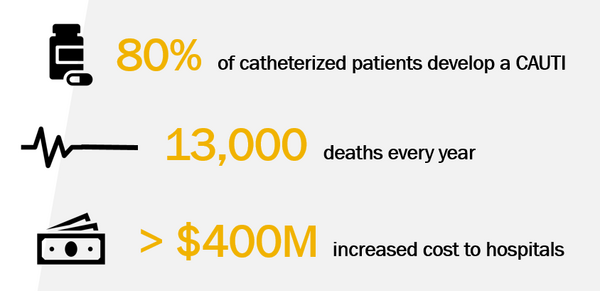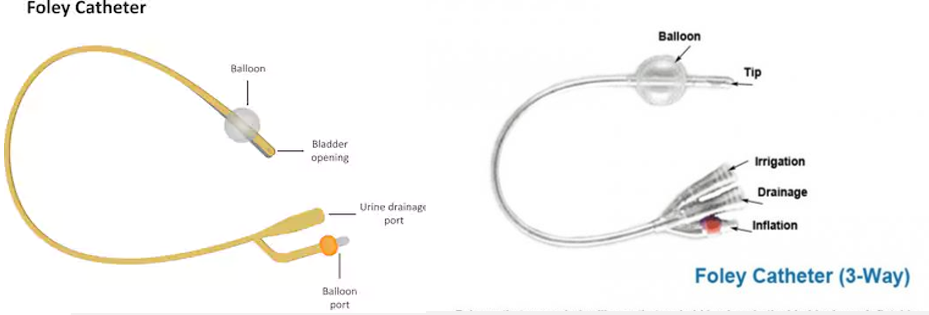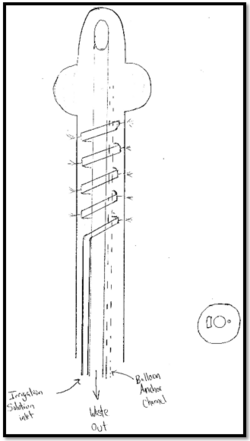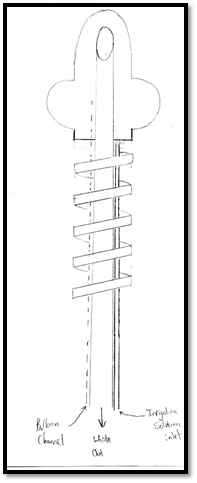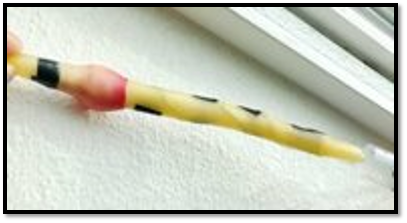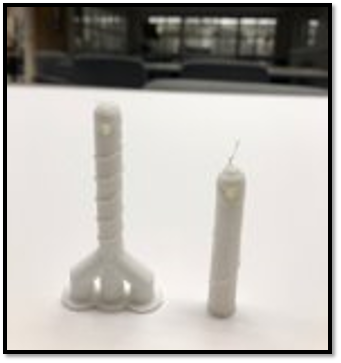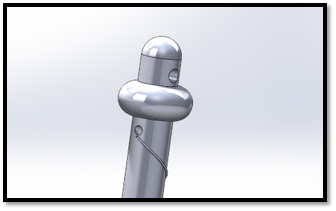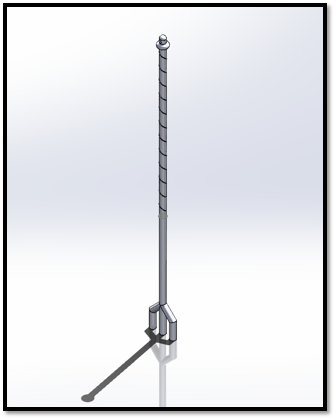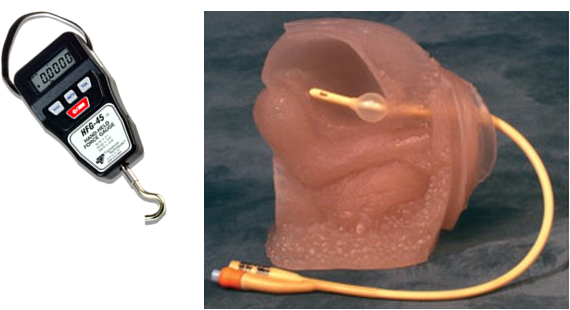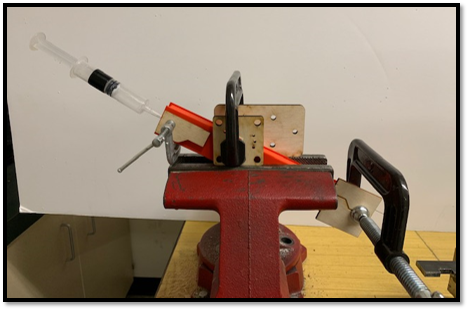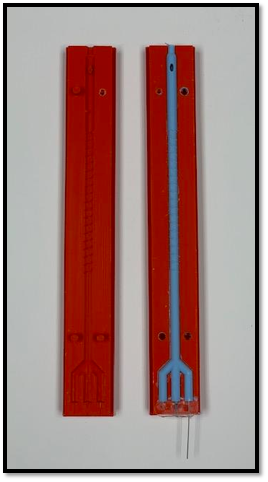Infection Prevention Urinary Catheter
| Sponsors | |
| Team Name | Infection Protection |
| Duration | Fall 2018 - Spring 2019 |
| Faculty Adviser |
|
| Mentor |
|
| Client |
|
| Team Members |
|
The goal of the project is to design and develop a urinary catheter that can reliably reduce the incidence of Catheter-Associated Urinary Tract Infections (CAUTIs).
Problem Definition[edit | edit source]
Background[edit | edit source]
Catheter-Associated Urinary Tract Infections (CAUTI)
- Indwelling urinary catheters are commonly used in both hospitals and nursing homes to help relieve patients with urinary incontinence or urinary retention. The use of a catheter allows the patient to empty their bladder. In most occurrences, catheters are used until the person can regain control of the bodily function, however, in many instances with elderly people or with individuals who have a permanent injury of illness, catheters are used on a long-term or permanent basis. While it is a very important device used in the healthcare industry, there is a large problem associated with the use of the traditional Foley catheter. Long-term catheter usage (2 weeks or more) is closely associated with high rates of Catheter-Associated Urinary Tract Infections (CAUTIs).
- CAUTIs are the most common type of nosocomial (hospital-related) infection
- About 23% of patients in US hospitals require the use of a urinary catheter
- The risk of acquiring a CAUTI increases by about 3-7% each day that an indwelling urinary catheter remains inside the patient
- These infections cause more than 13,000 deaths in the United States every year, and also create over $400M worth of increased costs to the care facilities that have to pay for treatments, etc. resulting from the CAUTI.
The clients for this urinary catheter re-design project were made aware of this healthcare problem by a relative who is currently a medical student. As a well-known issue with urinary catheters, Dr. John Crepeau and George Tanner of the University of Idaho were compelled to present this problem with the hopes of creating a new urinary catheter that would prevent harmful CAUTIs, spare thousands of lives, and save millions of dollars for the healthcare industry.
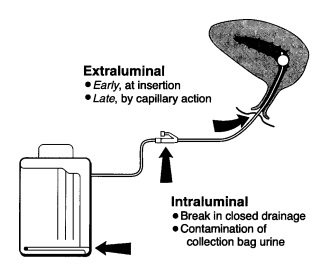
|
Value Proposition[edit | edit source]
- Currently, in the medical field, CAUTIs are perceived as an inevitable illnesses. Team Infection protection focuses on CAUTI prevention to give patients and healthcare workers peace of mind.
Deliverable[edit | edit source]
- Develop a catheter design that will reduce bacterial growth and build-up within the urinary tract. The design must be manufacturable on a large scale basis, and it must be adaptable in size.
Specifications[edit | edit source]
- The catheter shall allow for quick and easy insertion, anchoring, and removal. The anchor shall deploy once inserted in the bladder. At no point prior to removal shall the catheter slip from the bladder due to an anchor failure. Upon removal, the anchor shall be quickly and carefully released, leading to a smooth catheter withdrawal.
- The design must employ a mechanism which will allow solution/antibiotics to be pumped through the catheter to flush out the bladder and the urethra in order to prevent bacteria from building up, and consequentially causing an infection. Additionally, there must be a port and channel with the ability to connect/disconnect to a pump or syringe system which will be used to inject the system-flushing fluid.
| Design Area | Specification |
|---|---|
| Design Metrics |
|
| Patient Metrics |
|
Design Considerations[edit | edit source]
|
The 2-way Foley catheter seen above is the most common indwelling urinary |
The 3-way Foley catheter is less common. It is primarily used with |
Project Learning[edit | edit source]
Design Concepts[edit | edit source]
| Concept | Advantages and Disadvantages |
|---|---|
| Embedded Spiral |
|
| Outer Spiral |
|
Understanding the Root Cause of Infection[edit | edit source]
While using a catheter, a patient will become more susceptible to bacterial encroachment. The body has a natural defense to UTIs through recurrent urination throughout the day. A catheter inhibits the flow of urine in direct contact the urethra. Instead, urine flows intraluminally through the waste channel, and the urethra is left stagnant.
The anatomy of the human body leads to heightened risks of infection. Escherichia coli (E. coli) is the most common type
of bacteria that causes UTIs. The E. coli typically migrates from the anal cavity to the external urethral orifice (opening).
Once the bacteria has entered the urinary tract, it can spread all throughout the urethra to the bladder, and if not treated,
into the bloodstream.
Early Prototyping Methods[edit | edit source]
| Dip Method |
|
| 3D Printing Method |
|
Chosen Design (preCAUTIon Catheter)[edit | edit source]
Composition[edit | edit source]
|
How It Works[edit | edit source]
|
Validation[edit | edit source]
Flow Test[edit | edit source]
|
The flow test visually demonstrates how the urethra is irrigated to flush bacteria from the urinary tract. To set up this test the preCAUTIon Catheter was inserted into clear tubing so the test could be easily observed.
|
Bacteria Test[edit | edit source]
|
- Results
- The "cloudy" streaks on the control plate indicate substantial bacterial growth on the Foley catheter. The few spots on the experiment plate demonstrate the preCAUTIon Catheter's ability to effectively remove bacteria from the urethra.
Insertion Test[edit | edit source]
|
Healthcare professionals expect full catheterization is attainable without exceeding an applied force of 1.12 lbf (5N) to the catheter. The key components used for the insertion test were a catheterization model and a force gauge. The insertion test was conducted with a commercially available Foley catheter and the preCAUTIon Catheter. The following steps describe the testing process:
|
|
Manufacturability[edit | edit source]
How the Foley Catheter is Made[edit | edit source]
- The first step in the manufacturing of a Foley catheter is the production of the long, thin tube that will be inserted into the bladder. The liquid rubber silicone is poured into a room temperature vulcanization (RTV) rubber mold. The mold is shaped like the desired catheter with either two or three outputs.
- The silicone is then heat cured. This procedure can take anywhere from 0.5 to 40 hours. Once cooled, the tube is withdrawn from the mold.
- A small opening is then punched in the distal end of the tube furthest away from the two outputs.
- A thin band of cured latex is slipped over the tube by hand to form a sheath around the tube. It is positioned so that the latex covers the opening that has been punched in the tube.
- To form the balloon, the entire length of the tube is dipped in latex, which creates an overcoat layer and bonds the band to the tube proximate to the distal and proximal ends of the band, forming the balloon. This adds to the thickness of the balloon and is used to adjust the outer diameter of the tube to the desired size.
- The catheter is then transported to the packaging center where it is put into a kit with a needleless syringe (to fill the balloon) and a drainage bag
- Read more about catheter production here
Slight Change in the Manufacturing Process[edit | edit source]
|
|
- To produce the preCAUTIon Catheter on a large scale, the only projected adjustment in the manufacturing process would be to alter the mold in which the silicone is poured. The remaining steps will remain the same.
Project Conclusion[edit | edit source]
- The innovative design allows for the removal of harmful bacteria from the urinary tract
- The preCAUTIon Catheter Provides a relatively atraumatic insertion, with potential to make removal less traumatizing than it currently is
- The design can be easily manufactured based on current practices
- Additional testing is required to further assess the design
Team Members[edit | edit source]
Team Infection Protection[edit | edit source]
|| Ed Hall
Major: Mechanical Engineering
| |
| Amy Macias
Major: Biological Engineering
| |
| Elena Tipton
Major: Mechanical Engineering
|
Additional Documentation[edit | edit source]
Project Schedule
Meeting Agenda
Meeting Minutes
File:2018 IPUC Meeting Minutes.pdf
Presentations
File:2018 IPUC PreliminaryPresentation.pdf
File:2018 IPUC ConceptDesignReview.pdf
File:2018 IPUC Engineering Release Review.pdf
File:2018 IPUC EXPO.pdf
Budget

